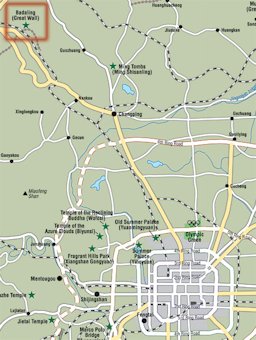
|
Our 2008 China Eclipse Trip - Page 5 Trip to Great Wall
The wall's construction began during the Warring States Period (403 to 221
BC). The Great Wall is a fortification along the northern and northwestern
frontier of China, running from Shanhaiguan on the Gulf of Bohai on the east to
the vicinity of Gaodai, Gansu Province, on the west, with an inner wall running
southward from the vicinity of Beijing almost to Handan. Shi Huangdi, first
emperor of the Chin dynasty erected the largest portion of the wall as a
defense against raids by nomadic peoples. Systematic work on the wall was begun
about 221 BC, after Shi Huangdi had united China under his rule, and it was
finished about 204 BC. Small sections of the wall were probably already in
existence, but Shi Huangdi is supposed to have had some nearly 1,200 miles of
the wall erected during his reign.
|
| Map Beijing to Badaling |